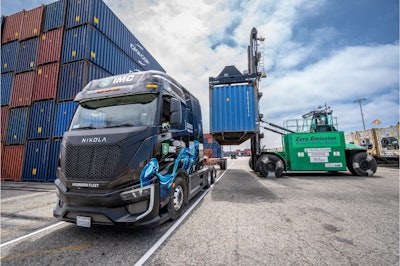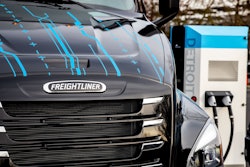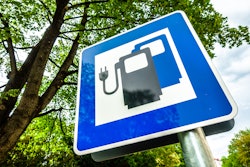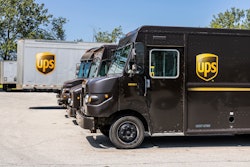
IMC Logistics, the largest marine drayage company in the United States, has taken its smart peel pile process to the next level: zero emission.
In 2020, Collierville, Tennessee-based IMC began development of a proprietary version of the peel pile concept that it now markets as SmartStacks. As containers arrive at a terminal, those for participating IMC customers are grouped into separate SmartStacks piles for priority service. Unlike a regular peel pile, in which all containers are typically hauled to a single location, containers in a SmartStacks pile could be destined for any number of inland terminal locations.
Using a proprietary app developed by IMC, once the driver receives the container in the terminal, they instantly see the container’s destination and can deliver the load to the final location. Drivers self-assign the most available container versus a specific one, leading to fewer unproductive lifts for terminal operators and less time waiting for the driver.
"With this solution, we're able to offer our customers a sustainable way to evacuate containers from the terminal," said Mason George, President of National Accounts at IMC, "while quickly delivering their containers in just two days or less."
While the SmartStacks initiative itself is a green one through increased efficiency and less idling, last week a notable zero emission milestone was cleared. IMC Logistics and Fenix Marine Services (FMS) have joined forces to operate the supply chain industry's first fully clean energy SmartStack. FMS segregated and stacked the containers designated for the IMC SmartStack at their Los Angeles-area terminal using their hydrogen fuel cell top-pick handler. IMC drivers then picked up and delivered containers using their fleet of zero-emission vehicles.
The State of California recently passed the Advanced Clean Fleets Rule, requiring trucking companies that provide drayage services to adopt an increasing amount of Zero Emission Vehicles (ZEVs) to their fleets. By 2035, the law says all trucks entering seaports or intermodal rail yards must be ZEVs. IMC is currently running electric and hydrogen trucks ahead of the mandate, with the goal of transitioning their fleet to zero-emission vehicles by 2028.
To support the charging of its ZEVs, IMC installed a system of chargers for our electric tractors with internal battery storage, allowing the carrier to charge the tractors any time, regardless of electrical grid status. The charging stations then replenishes itself when the grid stress is lower, reducing infrastructure stress.
All IMC facilities in California have been upgraded to both interior and exterior LED lighting to dramatically reduce energy consumption. The IMC transload facility located in Compton has converted to an all-electric forklift model and there is a Battery Electric Yard Hostler onsite. The Compton facility is powered by 100% renewable energy and completely carbon neutral.













